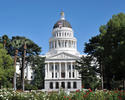The recent rash of fires, like the drought that preceded it, has sparked a new wave of pessimism about the state’s future. But the natural disasters have also obscured the fact the greatest challenge facing the state comes not from burning forests or lack of precipitation but from an increasingly dysfunctional society divided between a small but influential wealthy class and an ever-expanding poverty population. read more »
The California Exodus is Real
Not unlike the Hebrews departing Egypt and the Okies exiting the dust and famine of the 1930’s Midwest, the number of Californians getting the heck out of Dodge—so-to-speak—is staggering.
Between 2004 and 2013—in just one decade--about five million Californians left the state. Roughly 3.9 million people came here from other states during that period, for a net population loss of more than one million people. The trend resulted in a net loss of about $26 billion in annual income. read more »
- Login to post comments
Jews Could Swing the 2020 Election — and Why That's Not a Good Thing
In our selfie-defined culture, it’s usually considered a good thing to get attention, the more the better. But it may not be the case for Jews, or for Israel, to be caught in the firestorm that is burning through American politics in ways not seen since the Second World War. “That Israel is becoming a wedge issue in American politics,” notes author Daniel Gordis, “ bodes very badly for Israel’s future security.” read more »
- Login to post comments
Scapegoating Ride Hailing
Transit ridership in Chicago is declining. The city wants to tax ride-hailing companies such as Uber and Lyft and give some of the money to the Chicago Transit Authority (CTA). read more »
- Login to post comments
Why America’s Free Market Economy Works Better in Some Places than Others
Is America’s free market system working as advertised? Mostly yes, but it depends to a surprising degree on where you live.
read more »- Login to post comments
Gov. Newsom Throws California's Interior Under the Bus
Gov. Gavin Newsom has committed himself to look for ways of “unlocking the enormous potential” of the Central Valley, but in reality he seems more interested in slamming the door to its prosperity behind him.
In two critical moves the former San Francisco mayor has shown his incomprehension of how to address the needs of the vast California interior, particularly the over 6.5 million people in the 17 counties of the Central Valley. read more »
- Login to post comments
Democracy is For the Dogs
With a new round of state and local elections just around the corner, I am regularly asked about what brings Americans out to the polls and helps them politically engage them with their communities. read more »
- Login to post comments
The Expanding and Dispersing San Francisco Bay Area
This decade has witnessed an unprecedented expansion of the Greater San Francisco Bay Area (the San Jose-San Francisco combined statistical area or CSA), with the addition of three Central Valley metropolitan areas, Stockton, Modesto and Merced. Over the same period, there has been both a drop in the population growth rate and a shift of growth to the Central Valley exurban metropolitan areas. read more »
- Login to post comments
California Wildfires Ignite New Funding Battles with DC Lawmakers
As California continues to throw good money after bad and baste in the fires of its own Gehenna, the White House has threatened to cut off emergency aid (FEMA) to residents displaced by the recent forest fires.
The state’s mismanagement of past funds has put it in the situation it is in today. Rather than patch the hole in the sinking ship the state would rather bring in a larger sump pump to evacuate the water. The water in this case is actually its fire maintenance budget and the sump pump represents more FEMA funding. read more »
- Login to post comments
Forced Upzoning is Bad Policy, But Here's How We Can Mitigate its Impacts
A number of bills in the legislature would attempt to “solve” the state’s housing challenges by overriding local municipal zoning ordinances and statutorily allowing developers to build up to Sacramento-mandated levels of density. The most notable of these bills is SB50, which has no provisions to make any of the housing built affordable, but espouses a “trickle-down” theory which suggests that market-rate (i.e. luxury) housing will “filter” down to create more affordable housing. read more »
- Login to post comments






















